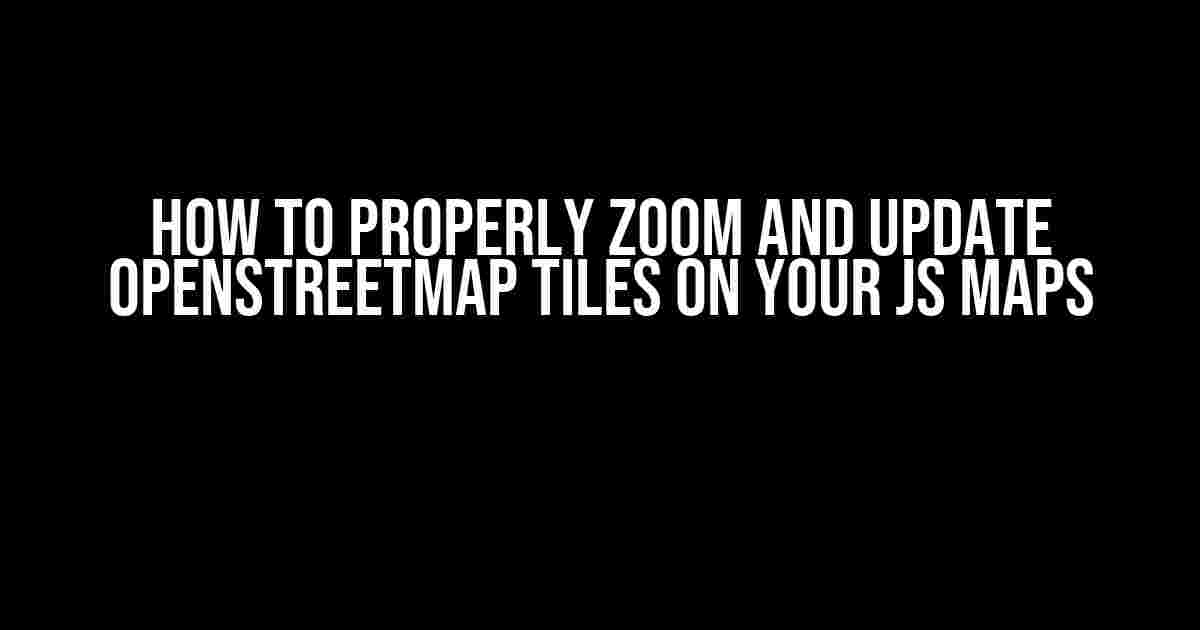Are you tired of dealing with blurry or outdated maps on your website? Do you want to learn how to properly zoom and update OpenStreetMap (OSM) tiles on your JavaScript maps? Look no further! In this comprehensive guide, we’ll take you by the hand and walk you through the process of optimizing your OSM tiles for a seamless user experience.
Why Update OSM Tiles?
Before we dive into the nitty-gritty, let’s talk about why updating OSM tiles is crucial for your website’s map functionality.
- Fresh Data: OSM tiles are constantly being updated by a community of volunteers, which means that new roads, buildings, and points of interest are being added all the time. By updating your tiles, you ensure that your users have access to the most recent and accurate data.
- Improved Performance: Outdated tiles can lead to poor map performance, including slow loading times and blurry images. By regularly updating your tiles, you can improve the overall user experience and reduce the risk of frustrated users.
- Enhanced Customization: Updating your OSM tiles gives you more control over the design and layout of your map, allowing you to tailor it to your specific needs and branding.
Understanding OSM Tiles
Before we can dive into the update process, it’s essential to understand how OSM tiles work.
OSM tiles are small, square images that are combined to form a larger map. Each tile is 256×256 pixels in size and represents a specific geographic area. The tiles are organized into a grid, with each tile having a unique identifier (z/x/y) that defines its position and zoom level.
| Tile Identifier | Description |
|---|---|
| z | The zoom level of the tile, which ranges from 0 (global view) to 19 (street-level view) |
| x | The x-coordinate of the tile, which increases as you move east |
| y | The y-coordinate of the tile, which increases as you move north |
Zooming and Updating OSM Tiles
Now that we’ve covered the basics, let’s dive into the meat of the article: zooming and updating OSM tiles on your JS maps.
Step 1: Choose Your Mapping Library
There are several JavaScript mapping libraries available, each with its strengths and weaknesses. For this example, we’ll use Leaflet.js, a popular and widely-used library.
<script src="https://unpkg.com/[email protected]/dist/leaflet.js"></script>
<link rel="stylesheet" href="https://unpkg.com/[email protected]/dist/leaflet.css"/>
Step 2: Create Your Map Container
Create a container element for your map, and set its width and height to 100%.
<div id="map" style="width: 100%; height: 100vh;"></div>
Step 3: Initialize Your Map
Initialize your Leaflet map and set the initial zoom level, center coordinates, and tile layer.
var map = L.map("map").setView([51.505, -0.09], 13);
L.tileLayer("https://{s}.tile.openstreetmap.org/{z}/{x}/{y}.png", {
attribution: '© ',
subdomains: ["a", "b", "c"]
}).addTo(map);
Step 4: Update OSM Tiles
To update your OSM tiles, you’ll need to fetch the latest tile data from the OSM server and replace the existing tiles with the new ones.
function updateTiles() {
var tileLayer = map.getLayer("tile");
tileLayer.setUrl("https://{s}.tile.openstreetmap.org/{z}/{x}/{y}.png");
tileLayer.redraw();
}
// Set the update interval to 1 hour (3600000 ms)
setInterval(updateTiles, 3600000);
Step 5: Handle Zooming and Panning
To handle zooming and panning, you’ll need to add event listeners to your map container.
map.on("zoomend", function() {
updateTiles();
});
map.on("dragend", function() {
updateTiles();
});
Optimizing Your OSM Tiles
Now that you’ve learned how to update your OSM tiles, let’s talk about optimization techniques to improve performance and reduce the risk of tile overload.
Tile Caching
Tile caching involves storing frequently accessed tiles in local storage to reduce the number of requests made to the OSM server.
var cache = {};
function getTileUrl(z, x, y) {
var key = z + "/" + x + "/" + y;
if (cache[key]) {
return cache[key];
} else {
var url = "https://{s}.tile.openstreetmap.org/{z}/{x}/{y}.png".
replace("{s}", "a").
replace("{z}", z).
replace("{x}", x).
replace("{y}", y);
cache[key] = url;
return url;
}
}
Tile Preloading
Tile preloading involves loading tiles in the background before they’re needed, reducing the risk of tile overload and improving performance.
function preloadTiles(z, x, y) {
var urls = [];
for (var i = 0; i < 3; i++) {
for (var j = 0; j < 3; j++) {
urls.push(getTileUrl(z, x + i, y + j));
}
}
var img = new Image();
img.onload = function() {
img.onload = null;
};
img.src = urls[Math.floor(Math.random() * urls.length)];
}
Conclusion
In conclusion, updating and optimizing OSM tiles on your JS maps is a crucial step in providing a seamless user experience. By following the steps outlined in this article, you can ensure that your maps are always up-to-date, performant, and customizable to your specific needs.
Remember to stay tuned for future updates and improvements to the OSM tile system, and happy mapping!
Final Code
<script>
var map = L.map("map").setView([51.505, -0.09], 13);
L.tileLayer("https://{s}.tile.openstreetmap.org/{z}/{x}/{y}.png", {
attribution: '© ',
subdomains: ["a", "b", "c"]
}).addTo(map);
function updateTiles() {
var tileLayer = map.getLayer("tile");
tileLayer.setUrl("https://{s}.tile.openstreetmap.org/{z}/{x}/{y}.png");
tileLayer.redraw();
}
setInterval(updateTiles, 3600000);
map.on("zoomend", function() {
updateTiles();
});
map.on("dragend", function() {
updateTiles();
});
var cache = {};
function getTileUrl(z, x, y) {
var key = z + "/" + x + "/" + y;
if (cache[key]) {
return cache[key];
} else {
var url = "https://{s}.tile.openstreetmap.org/{z}/{x}/{y}.png".
replace("{s}", "a").
replace("{z}", z).
replace("{x}", x).
replace("{y}", y);
cache[key]Here are 5 Questions and Answers about "How to properly zoom and update OpenStreetMap tiles on my JS Maps" in a creative tone:
Frequently Asked Question
Get ready to map out your next adventure with these top tips on zooming and updating OpenStreetMap tiles on your JS Maps!
Q1: What's the best way to zoom in and out of my map?
To zoom in and out of your map smoothly, use the built-in zoom controls or wheel mouse events. You can also add custom zoom buttons using JavaScript and CSS. Just remember to adjust the map's max zoom level to avoid pixelation!
Q2: How do I update OpenStreetMap tiles to reflect changes?
To update OpenStreetMap tiles, simply refresh the map layer by calling the `invalidateSize()` method or by setting the `updateInterval` property to a desired time interval. This ensures you always have the latest map data!
Q3: What's the deal with tile caching?
Tile caching is a lifesaver for performance! It stores frequently accessed tiles locally, reducing server requests and improving map loading speeds. Just be sure to set a reasonable cache expiration time to ensure fresh data. You can also use libraries like leaflet-keep-bounds to optimize caching further.
Q4: How do I optimize map performance for mobile devices?
For mobile devices, it's crucial to optimize map performance by reducing tile size, using smaller tile buffers, and implementing lazy loading. You can also consider using libraries like leaflet-mobile to streamline your map's mobile experience. Happy mapping on-the-go!
Q5: Can I customize the map's zoom and update behavior?
Absolutely! You can customize the map's zoom and update behavior using various JavaScript libraries and plugins. For example, you can use leaflet's `zoomstart` and `zoomend` events to create custom zoom effects or use plugins like leaflet-realtime to update the map in real-time. The possibilities are endless!






